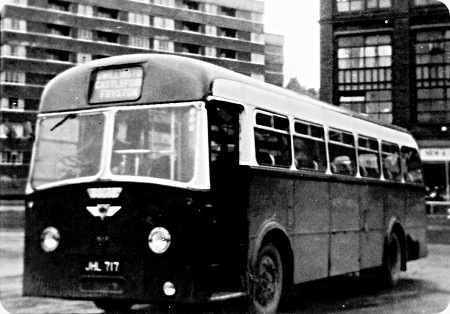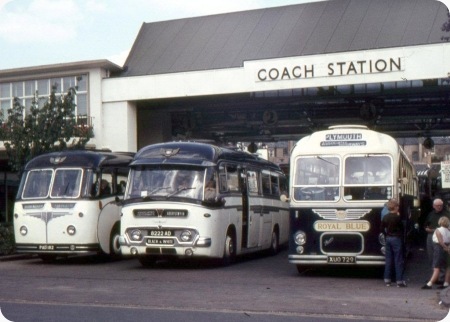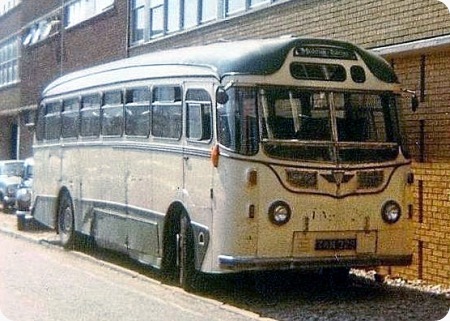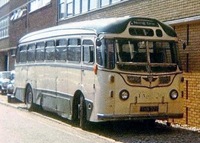
Copyright Chris Hough
West Riding Automobile
1956
AEC Reliance
Roe B44F
In the nineteen fifties West Riding bought very few batches of saloons They were used on a selection of routes. Seen in Leeds bus station is a Roe bodied AEC Reliance fleet number 817 registration JHL 717 which dates from 1956. It is on the "back roads route" from Leeds to Castleford via Swillington and Fryston. West Riding did not always bother with route numbers as is evident from this shot The bus certainly shows the effect of road grime on paintwork as it stands in Leeds bus station in 1967.
Photograph and Copy contributed by Chris Hough
01/08/12 – 07:19
Odd design- front not very Roe? It may well have picked that spray up that day on that back roads route- could be off the fields or clay slurry from mining. Note the single mini-wiper and the gloop around its perimeter, the state of the wheels/tyres and (possibly) the wet muck behind the rear wheels. It got better when the windows were covered too- that’s where the idea for the all-over adverts came from.
Nearly on thread: West Riding’s successors, Arriva, have just managed to provide a new batch of deckers with facing fore and aft seats over the rear wheels. Now where do the local yobbery put their muddy feet/boots? Arriva are now providing notices to try to stop people dirtying their clothes on muddy seats. Come back practical designers… conductors… inspectors!!
Joe
01/08/12 – 08:53
Actually, very Roe, Joe. For a time in the early fifties, this droopy windscreen was a feature of Roe saloons – and distinguished them from their Park Royal cousins built on the same frames. I like your theory about the origins of contra-vision adverts, though!
David Oldfield
01/08/12 – 11:59
As we Geordies would say "wor bairns hacky mucky" rough translation "the baby is in need of a wash"
Ronnie Hoye
01/08/12 – 12:01
What a dismal scene! Obviously a grotty day, when some photographers would leave the camera at home because of a) the weather and b) the resulting dirty appearance of the vehicle. There are some photographers of buses who capture only "pristine" views but there is a real world out there and it often happens that the cleaners can’t keep pace with the weather. It may just happen that the photographer is on holiday and wants to record the local transport. I know that doesn’t apply in this case, but what’s the photographer supposed to do, come back next year and hope the same bus is still in service?
Very atmospheric, and the black and white print enhances that. Thanks for sharing.
Interesting comment from Joe regarding back to back seating over the rear wheels. I first noticed this with Bolton Corporation, but the idea still persists. The original idea was to have greater seating capacity. The inward facing arrangement seems to me to be far better. Clearly, a candidate for the "nice idea, but . . ." file!
Pete Davies
01/08/12 – 15:38
While "facing seats" are not by any means ideal the abuse of them on both buses and trains is absolutely abominable. Its almost certain that, as you walk past any stationary bus, if you look inside you will see passengers with their filthy footwear planted on the opposite seat – and not just placed there either – there will be plenty of "scrubbing" in every direction just to plant more filth and to cause as much wear to the material as possible. It might be thought that those responsible would just be the yobs of Society, but not a bit of it – the culprits are just as likely to be smartly dressed businessmen or secretarial young ladies. It is a despicable and costly habit, of which the perpetrators are fully aware and, apart from the burden placed on transport operators, the ruination of decent peoples hard earned nice clothing is scandalous. In summary the phrase "Blow you Jack I’m alright" springs to mind, and in reality there can be no cure for it – its sadly just another sign of "Today."
Chris Youhill
01/08/12 – 17:37
You’re dead right, Joe and Chris. However, it seems to be a universal problem. I remember once risking my life by photographing a couple of youths on a German train with their feet on the seat directly under a large and unambiguous"Halten Sie Füße weg von den Sitzen"(or similar) sign and graphic image. Needless to say, they just laughed at me, but (who knows) maybe the memory of the occasion may just hit home to one of them in years to come? Staff, particularly on railways, rarely bother to challenge the offenders as they prefer a quiet life, and who can blame them? However, one can sometimes come unstuck by making big assumptions – like the time I worked myself into a Victor Meldrew Harumph on seeing a lady with outstretched legs onto the opposite seat in a first class carriage. I was on the brink of saying something when I thankfully noticed that she had removed her shoes and placed a newspaper on the seat to rest her stockinged feet! Phew! Nearly an "I’ll get my coat……." moment!
Paul Haywood
02/08/12 – 07:12
Would, the would be perpetrators on arriving home put their muddy /dirty shoes on their own furniture thus defiling their property, I think not.
David Henighan
02/08/12 – 07:13
Sometimes a bit of sarcasm works wonders, when I was at Armstrong Galley one of our drivers had a notice in his coach ‘if the floor is full please don’t hesitate to use the litter bin’ strangely enough it seemed to work
Ronnie Hoye
02/08/12 – 07:13
I acknowledge your knowledge, David. I was thinking of exclusive Roe users like Doncaster, but at that time they were still on half cabs! Underfloor came much later.
Joe
02/08/12 – 07:14
I thoroughly agree with Joe regarding back to back seating over rear wheel arches, they seem to be obligatory with modern day low floor buses. I witnessed one of Stagecoach leather coach seated Scania/ALX 400’s when only days old being so treated despite various notices asking that it not be done.
When I was a driver I would wherever possible make a point of loudly asking for all feet to be taken off all seats it seemed popular with most passengers except the thoughtless culprits, as Chris says another sign of "today" I’m glad that I retired 9 years ago.
Diesel Dave
02/08/12 – 07:15
I wholeheartedly agree about the comments made about yobs (and non yobs) putting their feet on the back to back seats, who knows what they could have stood in? A few years ago I went for a lengthy trip on the Yorkshire Coastliner service between Leeds and Scarborough and felt the need to contact the company about some matter or other, I honestly can’t remember what it was now. Anyway, I took the opportunity to mention that this seating arrangement was not ideal for such a long journey and that people sat on the back seat tended to use the facing seat as a footrest. Coastliner’s suggestion was that I should have had a word with the perpetrators!
Dave Towers
02/08/12 – 11:18
Dave Towers received a somewhat pathetic and "resigned" reply from Coastliner – did they also include a list of A & E departments along the route where Dave could receive attention to his injuries after the quite likely "smack in t’ mouth" which could result from "having a word."
I share Diesel Dave’s sentiments and I am glad that I retired eleven years ago – the level of appalling conduct by too many passengers is now beyond a joke – and I loved the career to a passion – so I can well understand how most drivers who are doing the job "just for a living" must feel.
Chris Youhill
02/08/12 – 11:20
Joe. This comes down to personal experience – if you had never come across the droopy screens then you would assume they did not exist, or were an aberration. I happen to be a Roe fan/"expert" – but presumably, with Doncaster connections, so are you. I’ve been caught out in the past myself.
David Oldfield
02/08/12 – 17:12
Tough attitude of passengers both young and old can be yobbish but to a degree the companies are also at fault. In Leeds the interior of vehicles are often filthy with old newspapers, tickets etc on buses just out of the depot. Minor vandalism such as graffiti is left in situ so Joe Public see an unloved uncared for bus that they think hmm the company don’t care why should I. I am old enough to remember buses smelling of disinfectant on leaving the depot not last nights takeaway!
Chris Hough
02/08/12 – 17:13
I seem to remember being told that the reason for the demise of inward facing seats over wheelarches, in favour of back to back ones, was an ‘elfen safety’ issue. It was reckoned that passengers could fall off these seats too easily when the bus cornered (yes, they did actually sometimes!).
I agree entirely with all the above sentiments regarding inconsiderate, yobbish behaviour on buses these days, and as someone who still has to drive buses for a living (albeit part-time now, after nearly 40 years full-time) for a major operator, it is heartening to know that at least a few of you sympathise with the hopeless situation we find ourselves in.
All too often, present day bus drivers are criticised for being uncaring and disinterested, and held totally to blame for the state of the industry today. Physically we may have it easier with our automatic gearboxes, power-steering and computerised ticket machines – no more grappling with crash boxes, heavy steering or snipping away at piles of Willebrew tickets etc. – but the job is much more stressful, frustrating and demoralising in a host of different ways that the PSV drivers and conductors of yesteryear could never envisage.
Passengers often complain that the "bus driver should have done something" when there has been yobbish, unsocial behaviour taking place but, as Chris rightly implies, one is certainly putting oneself at risk of abuse – at the very least of the foul verbal kind, and quite possibly of the violent physical kind – if one intervenes. It’s just not worth it.
The companies pay lip service to their official intolerance of this kind of behaviour, but otherwise just ignore the issue – probably for fear of appearing too authoritarian. Even yobs are fare-paying passengers so we must not upset them too much.
John Stringer
03/08/12 – 07:55
I remember these buses coming through Dewsbury on the joint West Riding/Yorkshire Woollen service 3 to Cullingworth. I believe one is being prepared at the Dewsbury Bus Museum.
Philip Carlton
09/08/12 – 09:30
If I may climb back over the seats to the subject of Roe Underfloor Designs of the 50’s…. checking with Peter Gould’s list, I see that Doncaster actually bought a single centre entrance Regal IV in 1951…it must have been a sort of Festival of Britain experimental fling, because they also bought the two 8ft double deckers- Regent III and CVD6- which they sold on as two wide (for the streets or the washer- the jury is out) and then the two all-Leyland PD2’s which were the last non-Roe deckers ever bought and, trolley-bodied, lasted nearly 20 years: the next year, I see they bought nothing! Anyway… the party was clearly over and they reverted to half cab Regal IIIs in 1953, which were more typical of this traditional fleet. But… my point is that I have found a pic of 21 and it doesn’t have droopy windscreens… angled two piece, it seems…… so the droopy screens came later…
Joe
11/08/12 – 07:27
Pontypridd U.D.C. had three 1957 Guy Arab LUF’s with Roe rear-entrance bodies and ‘droopy’ windscreens – try this link:- www.sct61.org.uk/ Lancashire United Transport had some Atkinson PM746H’s with Roe bodies with similar fronts also, see:- www.flickr.com/photos/
John Stringer
11/08/12 – 09:20
I’ll throw another one at you Joe. You mentioned square screens on Regal IVs – just like Sheffield’s 12 – 14. The droopies were only on Reliances (and contemporary underfloors) which would make them 1953 onwards – but still from "the early fifties".
David Oldfield
12/08/12 – 07:21
As Manuel said… I learn… I learn. Curious that the "square" underfloor body designs look better or more modern…like that Pennine Royal Tiger.
Joe
16/11/12 – 09:04
John mentions (02/08/12) the yobbish attitude of passengers sadly this attitude to other peoples property is prevalent in all walks of life. I work in the NHS and we have a constant problem with mindless vandalism to furniture in particular. I once asked a culprit if he would do the same to his own property and was met with a torrent of four letter words and told I pay your effin wages so shut it.
Chris Hough
 Vehicle reminder shot for this posting
Vehicle reminder shot for this posting
04/07/14 – 07:41
You get a fine from Merseyrail Electrics if you put your feet on their seats. There are signs up warning about it and they seem to work. Not that I use their trains very often.
Geoff Kerr





